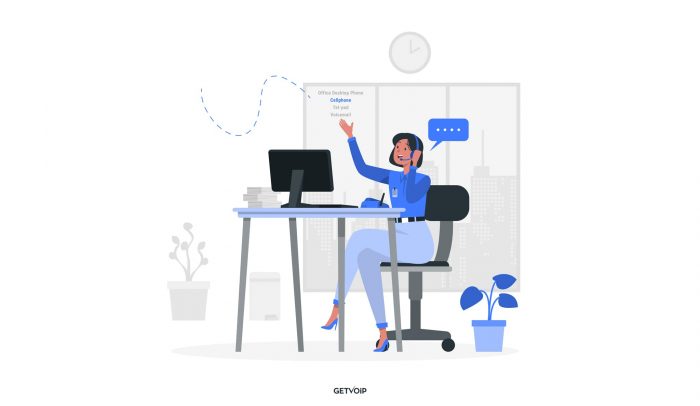Looking for the fastest way to improve your business’s customer experience?
You don’t have to spend thousands of dollars on agent training or add a new communication channel you’re not truly comfortable with.
Remember, it’s not just the ways you provide customer service -- it’s also about how quickly a customer gets the support they need. Recent studies show that the average customer is willing to wait on hold for a maximum of two minutes -- and over 80% of them said they expect an immediate response.
In this post, learn how call hunting, also known as Find Me/Follow Me, can slash customer wait and resolution times and prevent agents from getting overwhelmed by messages.
Table of Contents:
- What is Call Hunting?
- Who Benefits From Find Me/Follow Me?
- The Different Types of Call Hunting
- Call Hunting FAQs
What is Call Hunting?

Call hunting is a business phone system feature that distributes inbound calls made to one telephone number to multiple predetermined phone lines.
Also called line hunting and Find Me/Follow Me, incoming callers avoid busy signals and voicemail messages by automatically dialing all of an agent’s available telephone numbers -- often at the same time.
Additionally, it prevents agents from missing important business calls while out of the office on business trips or after-hours and provides a much higher level of agent flexibility. Plus, because inbound calls to one number are forwarded to others automatically, there’s no need to give clients your personal cell number.
Protect your privacy, take advantage of the mobility line hunting offers, and avoid returning to work to a full voicemail box.
Usually a standard hosted PBX and VoIP solution feature, line hunting lets agents/admins create a customized call path based on factors like:
- If the call is made during or after work hours
- If you want the caller to be able to leave a message
- If the calls should be forwarded to other users or groups of users (called ring groups or hunt groups)
- The number of rings before a call is forwarded to another line or extension
A sample call hunt path could look like:
During Work Hours → Cell → Home Phone → ACD Menu → Best Available Agent For Customer’s Request
/
Incoming Call → Desk phone number
\
After hours → Voicemail
Call Hunting vs. Call Forwarding vs. Call Routing
Though call hunting, call routing, and call forwarding, are similar, there are subtle differences between them.
As explained above, line hunting exhausts all options to connect an incoming caller to the desired representative.
Multiple phone numbers for that representative can be dialed one after another or at the same time, a process known as simultaneous ringing.
Call forwarding means that all incoming calls are directed to one telephone number.
For example, after 5:00 PM, work-related calls you’d normally answer at your desk phone are instead forwarded directly to your smartphone. Forwarding means incoming callers won’t have to make several calls to a few different phone numbers in order to reach the desired party.
The call forwarding path could look like:
Incoming Call → Desk phone number → Personal cell phone number → Voicemail
Call routing forwards incoming phone calls to multiple numbers, and sometimes multiple agents, according to set more complex answering rules.
For example, let’s say a client calls your customer support phone number. There was no answer on the first line, so the tool will forward calls to the next available agent designated in the dial path. Call routing also gives callers the opportunity to direct themselves to the correct extension/department by selecting options from your automated IVR system menu. Additionally, it uses historical caller data to direct their calls to the best possible department or individual agent.
A call routing path could look like:
Incoming Call to Customer Support phone number → Automated Self-Service Call Menu → Agent Specializing in Order Tracking → Additional Agent Assigned to Order Tracking → Department Manager → Voicemail
Find Me/Follow Me vs. ACD
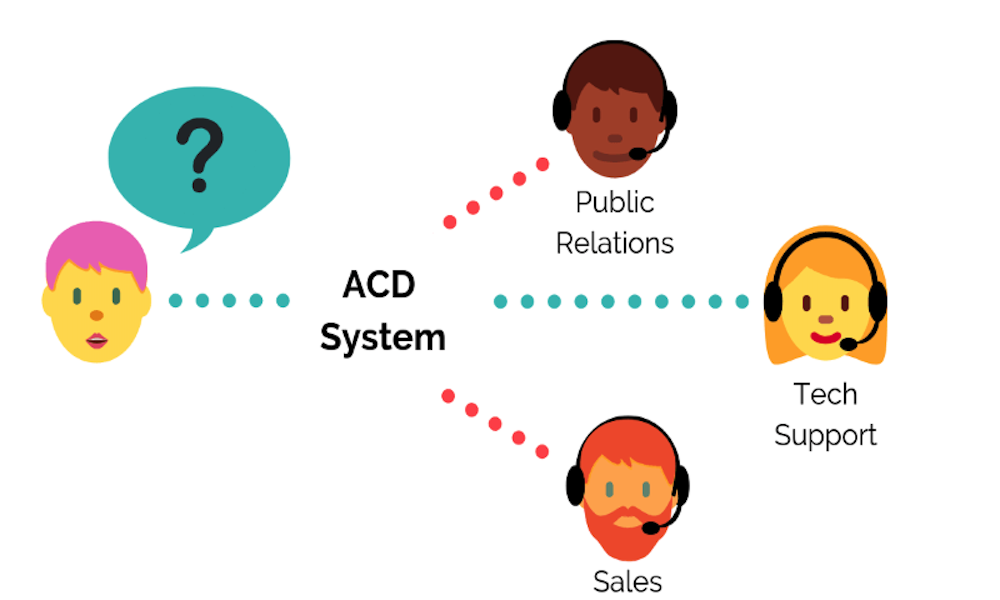
ACD, or Automatic Call Distribution, also uses IVR and CTI screen pops to help the incoming caller connect with the agent most qualified to assist with their particular issue.
Here, callers are placed in a queue that can involve hold times if the ideal representatives are currently on the phone. Think of it as an even more advanced kind of call hunting.
In Find Me/Follow Me, the goal is to reach one particular agent or department. With ACD and call routing, the specific agent the incoming caller connects with is less important. What matters more is that they’re connected with someone able to help them based on criteria like their call/order history, their overall priority as a client, or the specific question they have.
A sample ACD call path could look like:
Incoming Caller → IVR System → Technical Support Department → Calling Queue/Hold → Tech Support Agent 1 → Tech Support Agent 2 → Back to Main IVR Menu → Voicemail
Who Benefits From Find Me/Follow Me?
Any remote workforce, as well as any company that frequently has employees out of the office on business trips, conferences, or due to COVID restrictions, will benefit the most from Find Me/Follow Me features.
Customer service departments will see decreased customer wait times, meaning faster movement through call escalation matrixes, a higher level of agent availability, and a better overall customer experience.
Call centers will also benefit from more customer talk time and the increase in sales that comes from connecting the customer to the right agent as soon as possible. And since consumers can speak with in addition to a better overall customer experience.
More specifically, call hunting is essential within the healthcare and medical field, where being able to contact their doctor in the event of an emergency is essential.
The same goes for construction and manufacturing, where workplace accidents or even equipment malfunctions need to be reported to site managers and foremen.
Of course, call hunting is equally beneficial in less dire situations.
Clients can connect with their sales representatives to change meeting times or set up appointments and consultations. Management and higher-ups within both small businesses and enterprises can be available for essential decision-making calls no matter where they are.
Above all, employees can enjoy the freedom that comes with no longer needing to be tied to their desks.
The Different Types of Call Hunting
Users can customize numerous call hunting algorithms and paths, but there are a few options that are more consistently used.
The main types of call hunting are:
- Hunt groups
- Linear hunting
- Round-Robin hunting
- Most-idle hunting
Hunt Groups
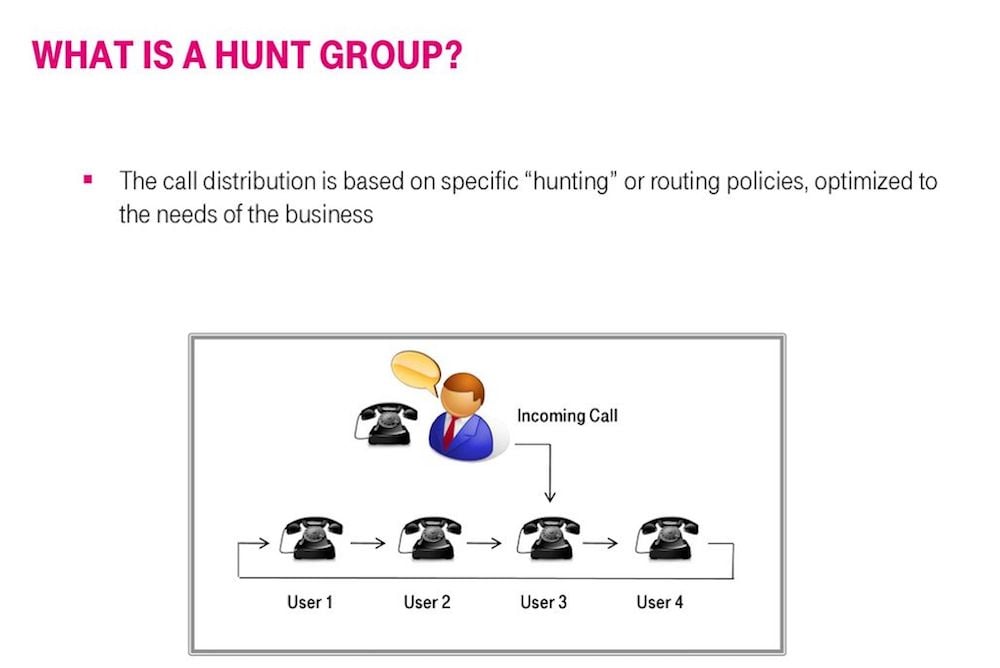
Large call centers with high call volumes must assign multiple agents to answer incoming calls to a phone number.
Hunt groups are the representatives that have been assigned to a specific phone number.
Simultaneous hunt group ringing means that every agent assigned to that number’s phone line will ring at the same time, and any available agent can answer the call. (After hours or if all agents are busy, callers can be redirected to voicemail or instructed to call back at another time.)
Linear Call Hunting
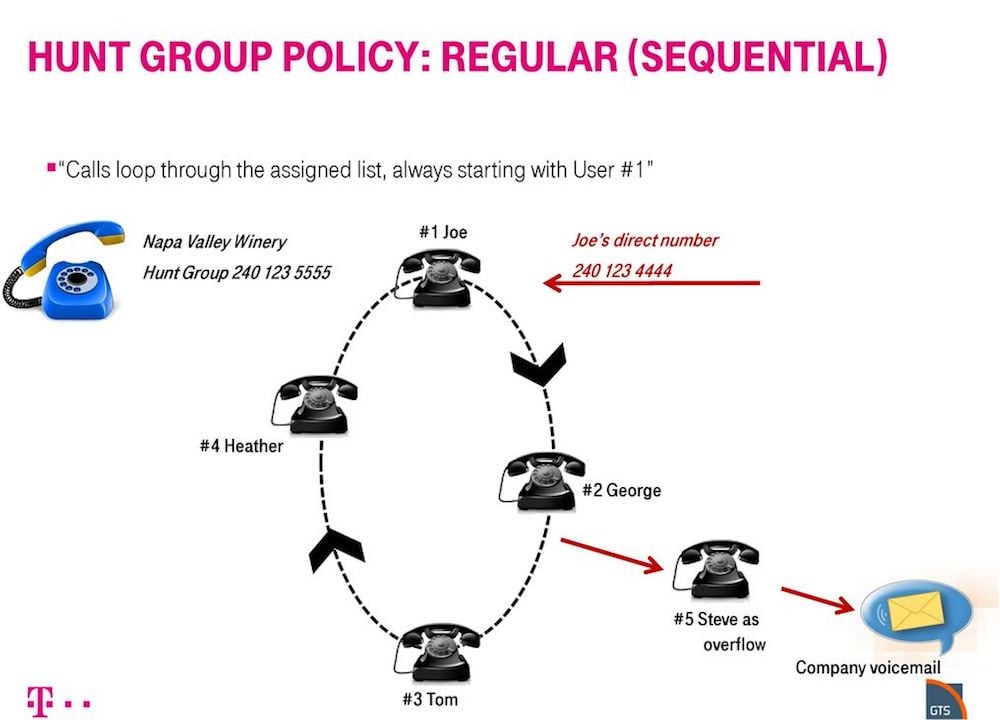
Also known as serial or top-down hunting, linear hunting dials agents sequentially according to their placement on a predetermined line group.
The incoming caller is essentially going “down the line” of possible available agents until they connect with an available representative. The call list order will remain the same with every incoming call unless the admin opts to change agents’ positions.
This method does not use simultaneous ringing and is best-suited to small businesses or those where every staff member is equally prepared to assist a customer. Otherwise, linear hunting may mean that an unqualified representative ends up on the phone with a customer.
Round-Robin Call Hunting
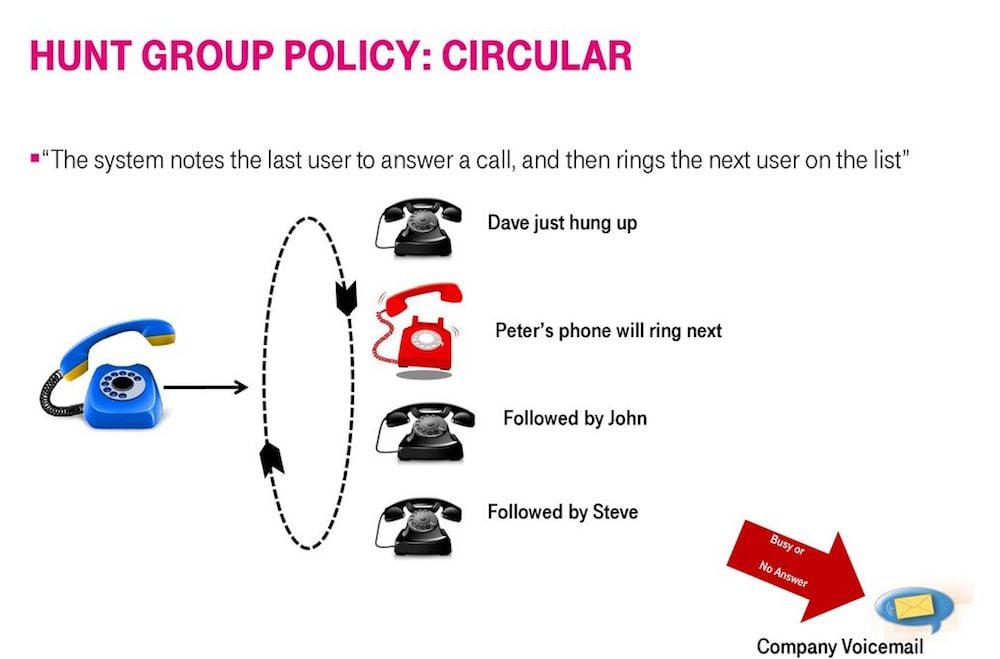
Round-robin or circular call hunting is a more equal method of distributing incoming calls, allowing agents to “take turns” at being the first available agent.
Let’s say you have three people in your customer service department hunt group: Alex, Jessie, and Sandy.
The first incoming caller would be directed to Alex. The next call would be directed to Jessie -- departing from the linear list method, which would once again result in Alex having the first chance to answer the call. After Jessie is connected to an agent, the third incoming caller would be routed to Sandy first. The cycle then repeats.
If no agents are available, customers can leave a voicemail or be directed to another ring group.
This method is well-suited for a sales environment where management needs to divide up leads fairly among representatives, or within customer support departments where agents may need to mark themselves unavailable to answer calls as they resolve an issue.
Most-Idle Call Hunting
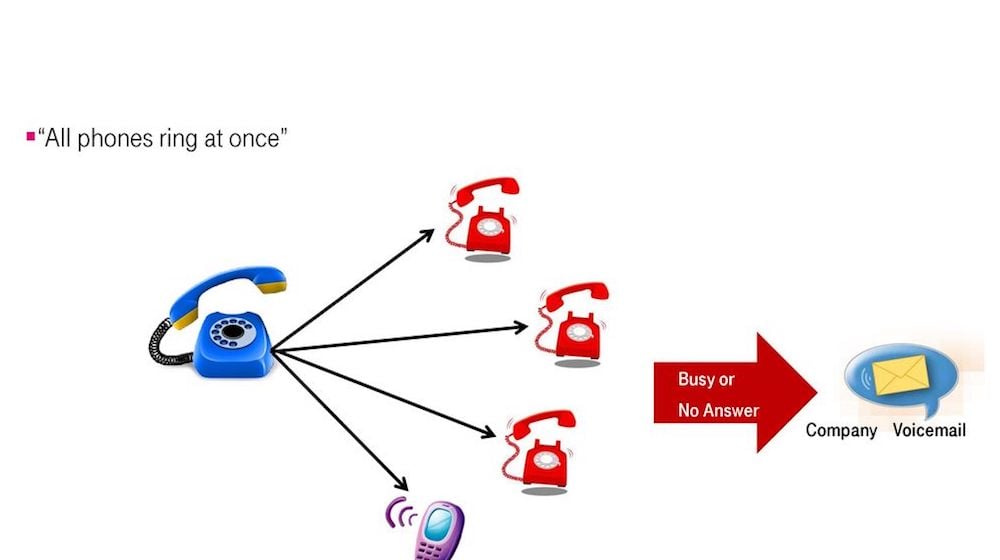
Most-idle call hunting first distributes incoming calls to the representative that has the highest overall idle time (the one that has gone the longest time without connecting with a customer on the phone.)
Note that only representatives who have entered into the idle state or who have marked themselves as idle will be considered for the most-idle call path. Agents who are on another call or who are currently designated as “available” will not be.
Admins can also opt to simultaneously broadcast an incoming call to all idle representatives within a call group.
This type of call flow is ideal for newer businesses that are still growing their client base, or call centers with a high number of employees. It also works well for those with long-distance employees that work across different time zones.
Call Hunting FAQs
Below, we answer some of the most frequently asked questions about call hunting.
How do you set up a Find Me/Follow Me call path?
In addition to following any of the call strategies mentioned above, admins can create their own unique paths in the call portal. They can also can reorder, add, and remove agents within a hunt group at any time.
How much does the call hunting feature cost?
Most VoIP plans offer the Find Me/Follow Me feature as a standard within their most affordable plan. However, in some cases, Find Me/Follow Me may be an add-on feature. Check with your individual provider for more pricing information.
Can agents be assigned to multiple hunt groups?
Yes, though remember this may mean that an agent ends up assisting a client with about a topic they haven’t been trained on, while the caller who needed help within that agent’s field of expertise doesn’t receive assistance from the best possible representative.
It may be best to limit the number of call groups an agent is in to three or fewer.
How many different hunt groups can you have?
Though this will vary based on the specific provider, most VoIP and call center platforms allow for up to 30 different hunt groups.
To learn more about the top VoIP providers that offer Find Me/Follow me and other advanced call routing options, use our comparison table to discover available plans and pricing, user reviews, and more.

